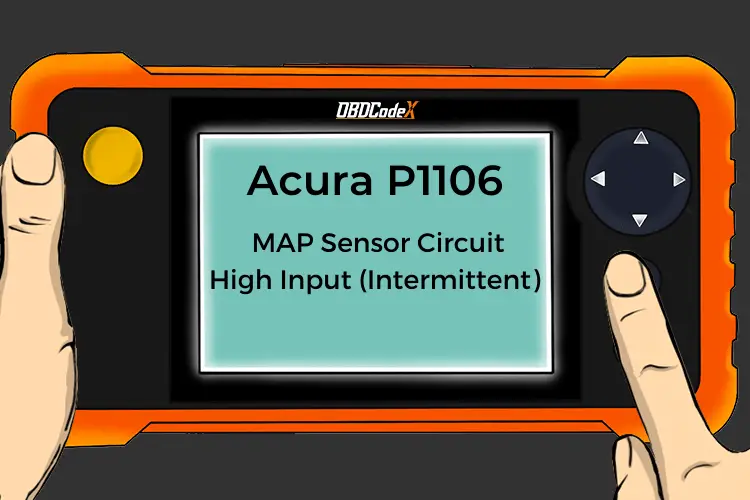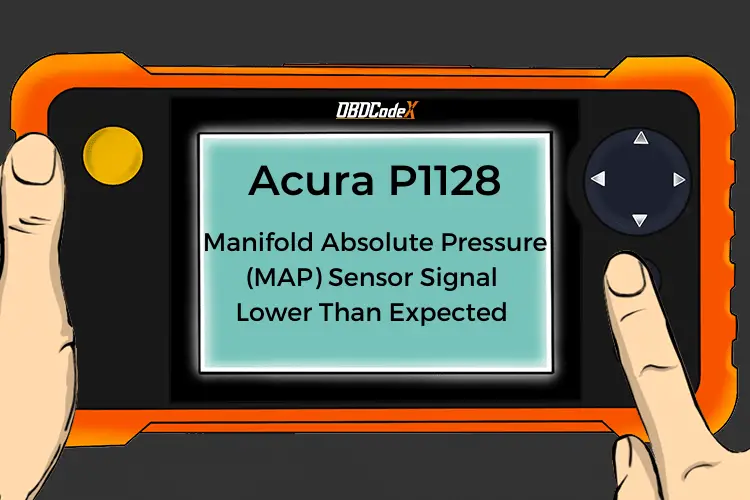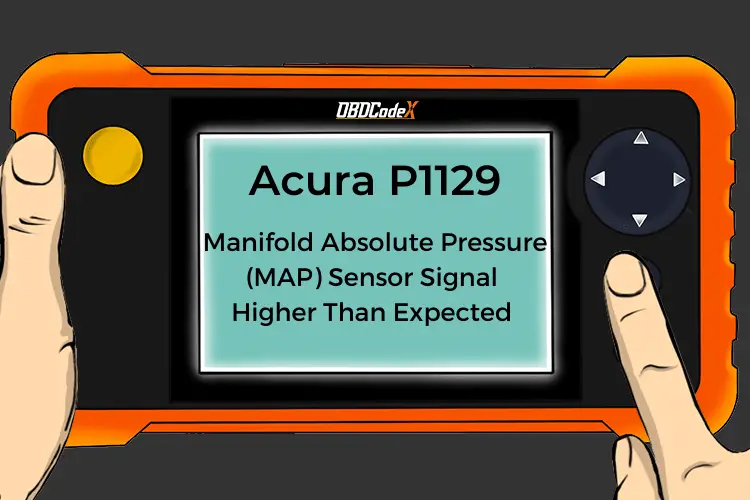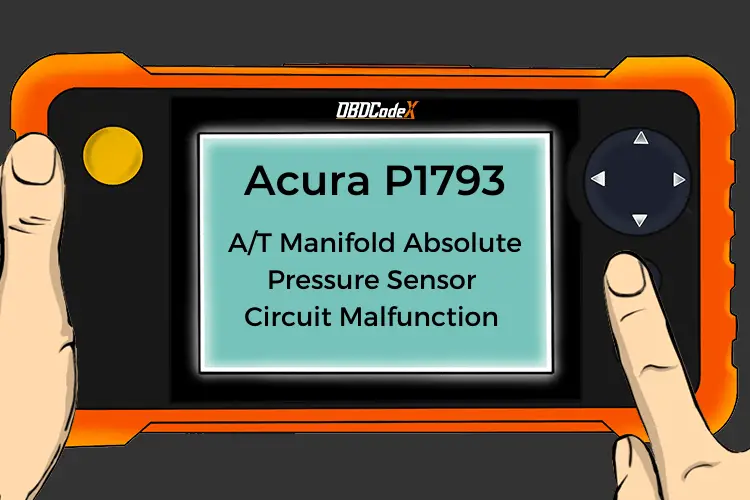P006A: MAP - Mass or Volume Air Flow Correlation Bank 1
Is your scanner showing P006A?
No worries. We'll show you what it means and how to deal with it.
P006A: MAP - Mass or Volume Air Flow Correlation Bank 1
OVERVIEWWhat Does The P006A Code Mean?
A stored code P006A, means that the powertrain control module (PCM) has detected a discrepancy in the correlating signals between the manifold absolute pressure (MAP) sensor and the mass or volume air flow sensor (MAF/VAF) for engine bank one.
Bank 1 denotes the bank of the engine which contains the number one cylinder. Consult a reliable vehicle information source for the location of the number one cylinder for the vehicle in question. Only vehicles that are equipped with multiple (one per engine bank) throttle body openings should exhibit this code.
Air density (pressure) in the intake manifold is reflected using the MAP sensor which supplies the PCM with a voltage signal. This input voltage signal is received (by the PCM) as either kilopascal (kPa) units or inches of mercury (Hg). In some cases, MAP is substituted for barometric pressure and measured in similar increments.
When the internal combustion engine is operating at peak efficiency, it creates a strong vacuum which must be restricted to only the throttle body opening/s. Vacuum is regulated by the throttle plate (controlled by the driver under acceleration) and the idle air control (IAC) valve when the engine is at idle. This vacuum effectively draws in the air required to complete each combustion cycle.
A precise fuel to air ratio is one of the most critical factors in achieving maximum fuel efficiency and the minimization of harmful exhaust emissions in mass produced vehicles. As the throttle plate/s are opened, air entering the intake manifold is measured by either the MAF or VAF sensor/s.
Fuel delivery and ignition timing strategy are calculated (by the PCM) using data contrived from these MAF or VAF sensor/s. Air which passes through these devices is referred to as metered air. Air which is involuntarily introduced to the engine (vacuum leaks) can contribute to excessively lean (too much air or not enough fuel) conditions and is called unmetered air.
There are two basic types of air metering devices:
MAF Sensor
This type of sensor is most often used in domestic vehicles. It is based around one or more thermal resistors which are suspended in the bore of the sensor housing, so that air can flow directly across them. One of the thermal resistors monitors MAF while the other measures intake air temperature (IAT).
Hot wire MAF sensors use voltage applied directly to a single resistor to monitor the amount of intake air which flows across it. As ambient air flow across the resistor is increased, the temperature of the resistor decreases resulting in a drop in the resistance level of the circuit. These changes in the resistance level of the circuit result in voltage variations which the PCM receives as a particular measure of metered air entering the engine intake manifold.
Cold wire MAF sensors usually look similar to hot wire sensors and use a similar system of metering intake air. In the cold wire MAF, a pair of thermal resistors also may be used. The first is positioned in a recessed area of the sensor housing and measures only ambient air temperature, as it enters the sensor.
The second thermal resistor is positioned near the center of the bore so that incoming air can flow across it, as the throttle plate is opened. When the engine is running, the PCM compares input voltage signals from each of these resistors to determine precisely how much metered air is being drawn into the engine.
VAF Sensor
The key difference between the MAF and the VAF is that the VAF is configured with a door or a flap that is opened by air that is drawn into the intake. This type of air metering device is used primarily in vehicles imported from Europe.
At idle, the spring loaded flap is secured in the closed position. When the throttle is opened, the door is forced open. The action of the door/flap on its hinge actuates a potentiometer that transmits a voltage signal to the PCM. The PCM recognizes these variations in potentiometer voltage as the degree of metered air being drawn into the intake.
A code P006A will be stored, and a malfunction indicator lamp (MIL) may be illuminated, if the PCM detects voltage signals between the MAP sensor and the MAF/VAF sensor (Bank 1) which differ by more than a programmed degree. MIL illumination may require multiple ignition cycles with a failure.
What Are The Symptoms Of The P006A Code?
Symptoms of a P006A engine code may include:
- Hesitation or stall upon acceleration
- Rich or lean exhaust
- Reduced fuel efficiency
- Diminished engine performance
What Are The Potential Causes Of The P006A Code?
Causes for this code may include:
- Defective MAP sensor
- Faulty or contaminated MAF/VAF sensor
- Open or shorted wiring or connectors in the related circuits
- Cracked or broken air inlet pipe
- Insufficient engine vacuum
- PCM or PCM programming error
How Serious Is This P006A Code?
Since fuel delivery and ignition timing are so critical to engine performance and efficiency, the P006A should be categorized as severe and addressed as such.
How Can You Fix The P006A Code?
A diagnostic scanner, a digital volt/ohmmeter (DVOM), a manual vacuum pressure gauge, and a reliable vehicle information source will be required to diagnose a code P006A.
A manual engine vacuum pressure test should precede diagnosing any MAP sensor related code. This may be done using the vacuum pressure gauge. If the engine is not making sufficient vacuum, it must be repaired before moving forward with your diagnosis.
Check the engine and all air inlet pipes for signs of cracking or breakage and make repairs as necessary. Vacuum leaks may contribute to the conditions which caused the P006A to be stored.
Visually inspect all related wiring and connectors if the engine is in good working order and there are no vacuum leaks. Make repairs as required.
Connect the scanner to the vehicle diagnostic port and retrieve all stored codes and freeze frame data. Write this information down as it may aid you in your diagnosis. Next, clear the codes and test-drive the vehicle to see if the code is reset.
If the code is immediately reset:
- Test the MAP sensor and the MAF/VAF sensor (Bank 1) using the DVOM. A reliable vehicle information source may yield valuable diagnostic information like component specifications, wiring diagrams, and connector views
- Use the DVOM on the ohms setting to test the individual sensors while they are unplugged
- Sensors which fail to comply with manufacturer’s specifications should be considered defective
If the sensors comply with manufacturer’s specifications:
- Use the DVOM to test for reference voltage (typically 5-volts) and a ground at sensor connectors
- Connect the positive test lead of the DVOM to the reference voltage pin of the sensor connector with the negative test lead connected to the ground pin of the connector
If reference voltage and a ground are detected:
- Reconnect the sensor in question and test its signal circuit with the engine running
- Follow the air pressure or air flow to voltage chart found within the vehicle information source to determine if the respective sensors are functioning properly
- Sensors which fail to reflect the degree of voltage (according to MAP and MAF/VAF) specified by the manufacturer, should be considered faulty
If sensor signal input voltage (at the sensor connector) reflects the correct degree of voltage:
- Use the DVOM to test the corresponding signal circuit (for the sensor in question) at the PCM connector. If an appropriate sensor signal is discovered at the sensor connector but not at the PCM connector, suspect that there is an open circuit between the PCM and the sensor in question
- Disconnect the PCM (and all related controllers) from the circuit and test individual system circuits using the DVOM. Follow the diagnostic flow chart or connector pin diagrams to test individual circuit resistance and/or continuity. Make repairs wherever required
Suspect PCM failure or a PCM programing error if all sensors and circuits are within specifications.
- Check technical service bulletins (TSB) for entries which match the vehicle in question (as well as the symptoms and codes stored) to help with your diagnosis
- The MAF/VAF sensor connector is frequently left unplugged after service is performed. If a P006A has presented immediately after air filter replacement, check this connector
Recommended Parts
Below are some recommended auto parts to help you address the trouble code affecting your vehicle and get it running smoothly again:
>>> MAP Sensor
>>> Air Inlet Pipe
>>> WORKPRO 582-piece Crimp Terminals, Wire Connectors, Heat Shrink Tube, Electrical Repair Kit
>>> ECU
>>> INNOVA 5210
>>> KAIWEETS Digital Multimeter
>>> OTC 5613 Vacuum/Pressure Gauge Kit
Note: During the purchasing process, please check carefully whether the part you want to buy fits your car!
Reference Sources
P006A: MAP – Mass or Volume Air Flow Correlation Bank 1, OBD-Codes.




